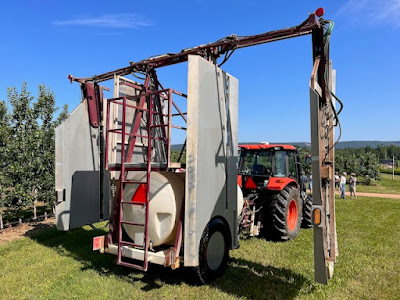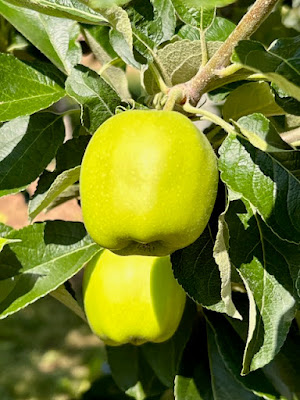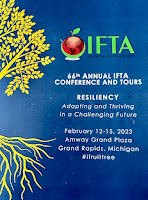 |
| Is this bitter pit? |
Yea, this is pretty half-baked all right, but meaning to look and summarize it for quite some time now, recently pushed by colleague Win Cowgill to look at B.10 in this data set based on a recent publication suggesting B.10 was really good at NOT having bitter pit with Honeycrisp as the scion. Humph...
OK, so this work was part of a much larger NC-140 sub-trial honchoed by Cornell's Terence Robinson and WSU's Lee Kalcsits to assess the incidence of bitter pit on Honeycrisp as affected by (many) rootstocks in two NC-140 Honeycrisp plantings, 2010 and 2014. In addition to percent bitter pit in the apples as I will line out below, apple peels were also sent off to Lee for nutrient analysis and Lee and his/our team are working on a real scientific publication (not half-baked) which I will try to update here when it comes out.
For the purposes of my results presented below, basically, 50 Honeycrisp apples (or less if there were not that many on the trees) were evaluated for bitter pit at harvest and after three months regular cold storage. These apples were on trees in the 2010 and 2014 NC-140 plantings at the UMass Orchard in Belchertown. And this was done in 2019 and 2020, although in 2019 the crop was light and there were not enough apples in the 2014 planting to evaluate for bitter pit. You will see what the rootstocks are included in the results. When evaluating the apples for bitter pit incidence, no evaluation was made for severity of bitter pit, apples either had bitter pit (1 or more pits) or not (zero pits). Got it?
OK, so here are the results, pretty self-explanatory, but then I will bullet-list caveats and my take-homes after. 😉 Note you can click on any of the tables/graphs to get a larger image if these are difficult to read (too small) or blurry...
 |
| % Bitter Pit (BP) after 3 months cold storage in 2019 in the 2010 NC-140 Honeycrisp apple rootstock planting. |
 |
| % Bitter Pit (BP) at harvest in 2020 in the 2010 NC-140 Honeycrisp apple rootstock planting. |
 |
| % Bitter Pit (BP) after 3 months cold storage in 2020 in the 2010 NC-140 Honeycrisp apple rootstock planting. |
- Although some general and obvious conclusions about rootstock effect on bitter pit incidence can be drawn here, there was missing data and different numbers of apples evaluated, i.e. not always 50 apples were available, so don't take these results to the bank. What follows though, I am pretty confident about saying.
- In the 2010 planting, in both 2019 and 2020, the only time there was a significant difference in % BP by rootstock was at harvest in 2019. There G.41 had significantly more BP than B.9, G.214, and the two M.9 clones. G.41, got that?
- I have been trained to not go here, but may we conclude a few things on the non-significant results in the 2010 planting in both years, 2019 and 2020? Yes, I have my reasons. G.41 is generally in or near the top of the list in % BP. B.9 is generally low or near the bottom of the list in % BP. Hmmm... B.10 exhibits more BP than B.9 but generally expressed less BP than most of the Geneva rootstocks. (Sorry Win and Sherif.) G.214 among the Geneva rootstocks seems less bitter pit prone and comparable to B.9 and M.9. I don't know what to say about M.26 but I don't generally recommend that rootstock for Honeycrisp. My theory on all this is the Geneva rootstocks are generally more vigorous than B.9 and M.9, set a lighter crop, and thus are more likely to have BP'd apples? Plus I understand research has shown some issues with various ratios of nutrient (Ca, Mg, and K in particular) uptake among the rootstocks.
- In the 2014 planting, there were significant differences in % BP vs. the rootstocks both at harvest and after 3 months cold storage. After cold storage, G.11 and G.41 were the worse but technically did not significantly differ from many of the other rootstocks. How come I did not have B.9 or B.10 in this planting? Good question. I clearly remember technician Jim (I miss him now) commenting when evaluating the bitter pit how bad the bitter pit was in the apples from the 11's and 41's. Also in terms of severity (how much bitter pit) he said which was not taken into account here. The vigorous V. (Vineland) rootstocks were generally pretty bad, and once again, among the Geneva rootstocks G.214 (4214) did not have that much bitter pit. I really like that rootstock, however, have been recently made aware of some winter hardiness issues with it.
- Bitter pit research is so very hard to do, there are so many factors that contribute to bitter pit development it is not even funny. See Dan Donahue's Honeycrisp Playbook (to mitigate bitter pit risk).
- For the reason mentioned above, Geneva rootstocks -- with maybe the exception of 214 -- are more pre-disposed compared to the less vigorous and heavy cropping (which has it's own downside) B.9. M.9's are in there with B.9 but might be more prone to bitter pit. The slightly more vigorous (than B.9) B.10 might be a better choice than G.11 or 41 with Honeycrisp (or any other bitter pit prone variety, Jonagold?) as the scion.
- I have a saying "friends don't let friends plant Honeycrisp on G.41" largely based on my overall experience, including in a significant commerical planting of Royal Red Honeycrisp on G.41 where the bitter pit therein has just been untenable (to date). And this is a good grower, the planting otherwise looks spectacular, although the crops have been lighter than desired. Oh wait, until 2023. Which has looked a lot better, very little bitter pit in that block. But a heavier crop and a very wet summer? And I understand the grower really threw the calcium at them this year after last years ugly look. I also have noted that my NC-140 Honecyrisp trees seem to have a lot less bitter pit than last year. This year's weather effect and a heavier crop? Or maybe as the trees get older they are settling down more? Although this is the 10th leaf, BP was bad last year in the 9th leaf. So I will temper a bit my saying above going forward. And there are obvious benefits to using Geneva rootstocks.












































